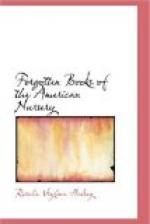Undoubtedly the success of Eliza Leslie’s “American Girls’ Book,” modelled after the English “Boy’s Own Book,” and published in 1831, added to the popularity attained by her earlier work, although of this she was but the compiler.
The “American Girls’ Book” was intended for little girls, and by dialogue, the prevailing mode of conveying instruction or amusement, numerous games and plays were described. Already many of the pastimes have gone out of fashion. “Lady Queen Anne” and “Robin’s Alive,” “a dangerous game with a lighted stick,” are altogether unknown; “Track the Rabbit” has changed its name to “Fox and Geese;” “Hot Buttered Beans” has found a substitute in “Hunt the Thimble;” and “Stir the Mush” has given place to “Going to Jerusalem.”
But Miss Leslie did more than preserve for us these old-fashioned games. She has left sketches of children’s ways and nature in her various stories for little people. She shared, of course, in the habit of moralizing characteristic of her day, but her children are childish, and her heroines are full of the whims, and have truly the pleasures and natural emotions, of real children.
Miss Leslie began her work for children in eighteen hundred and twenty-seven, when “Atlantic Stories” were published, and as her sketches of child-life appeared one after another, her pen grew more sure in its delineation of characters and her talent was speedily recognized. Even now “Birthday Stories” are worth reading and treasuring because of the pictures of family life eighty years ago. The “Souvenir,” for example, is a Christmas tale of old Philadelphia; the “Cadet’s Sister” sketches life at West Point, where the author’s brother had been a student; while the “Launch of the Frigate” and “Anthony and Clara” tell of customs and amusements quite passed away. The charming description of children shopping for their simple Christmas gifts, the narrative of the boys who paid a poor lad in a bookstore to ornament their “writing-pieces” for more “respectable presents” to parents, the quiet celebration of the day itself, can ill be spared from the history of child life and diversions in America. It is well to be reminded, in these days of complex and expensive amusements, of some of the saner and simpler pleasures enjoyed by children in Miss Leslie’s lifetime.
All of this writer’s books, moreover, have some real interest, whether it be “Althea Vernon,” with the description of summer life and fashions at Far Rockaway (New York’s Manhattan Beach of 1830), or “Henrietta Harrison,” with its sarcastic reference to the fashionable school where the pupils could sing French songs and Italian operas, but could not be sure of the notes of “Hail Columbia.” Or again, the account is worth reading of the heroine’s trip to New York from Philadelphia. “Simply habited in a plaid silk frock and Thibet shawl,” little Henrietta starts, under her uncle’s protection, at five o’clock in the morning to take the boat for Bordentown, New Jersey. There she has her first experience of a railway train, and looks out of the window “at all the velocity of the train will allow her to see.” At Heightstown small children meet the train with fruit and cakes to sell to hungry travellers. And finally comes the wonderful voyage from Amboy to the Battery in New York, which is not reached until night has fallen.




